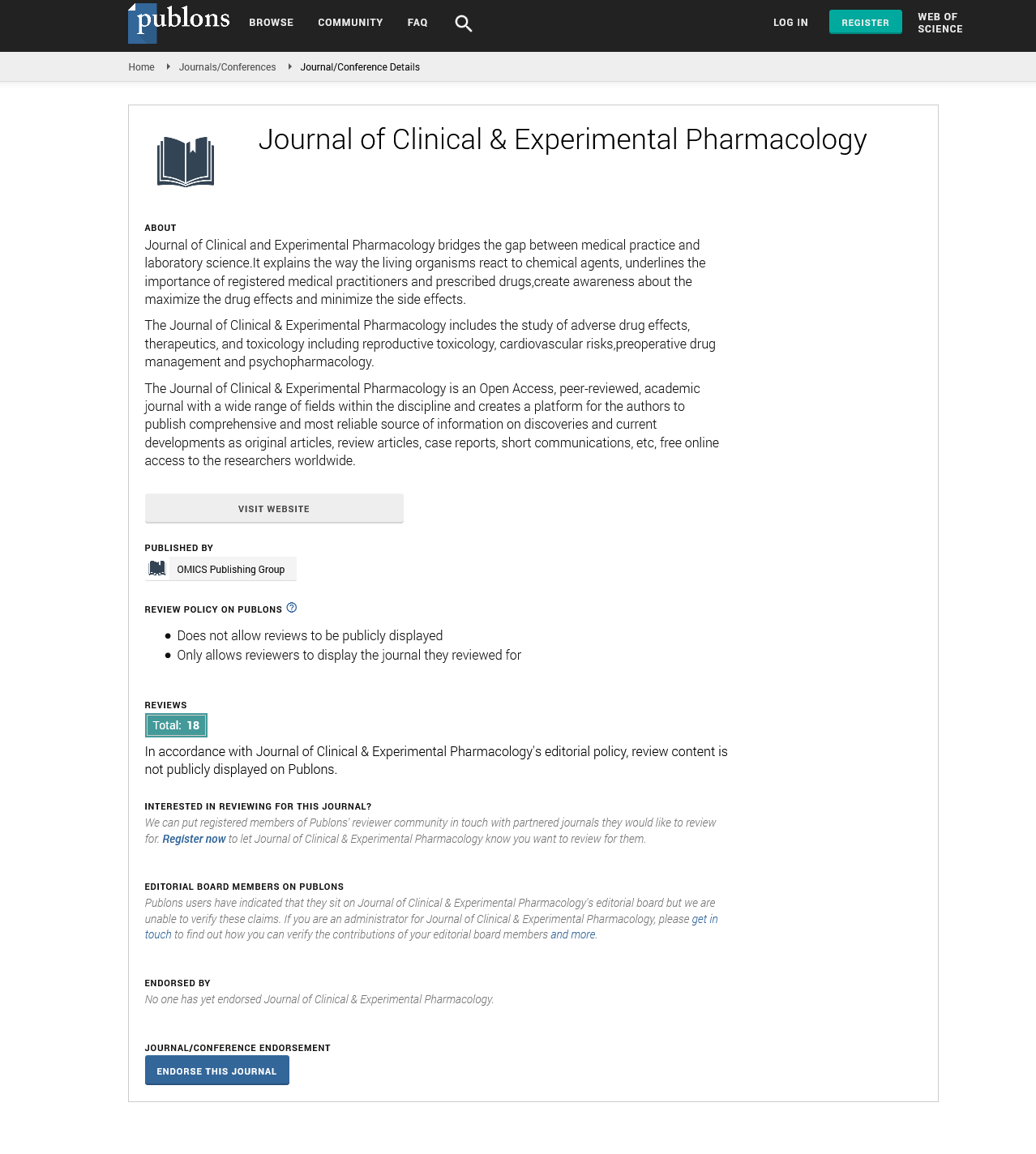Indexed In
- Open J Gate
- Genamics JournalSeek
- China National Knowledge Infrastructure (CNKI)
- Ulrich's Periodicals Directory
- RefSeek
- Hamdard University
- EBSCO A-Z
- OCLC- WorldCat
- Publons
- Google Scholar
Useful Links
Share This Page
Journal Flyer

Open Access Journals
- Agri and Aquaculture
- Biochemistry
- Bioinformatics & Systems Biology
- Business & Management
- Chemistry
- Clinical Sciences
- Engineering
- Food & Nutrition
- General Science
- Genetics & Molecular Biology
- Immunology & Microbiology
- Medical Sciences
- Neuroscience & Psychology
- Nursing & Health Care
- Pharmaceutical Sciences
Perspective - (2024) Volume 14, Issue 5
Neurosteroids and GABAA Receptors: Their Role in Major Depressive Disorder and Postpartum Depression
Rosaria Scheggi*Received: 23-Sep-2024, Manuscript No. CPECR-24-27575; Editor assigned: 25-Sep-2024, Pre QC No. CPECR-24-27575 (PQ); Reviewed: 09-Oct-2024, QC No. CPECR-24-27575; Revised: 16-Oct-2024, Manuscript No. CPECR-24-27575 (R); Published: 23-Oct-2024, DOI: 10.35248/2161-1459.24.14.448
Description
Major Depressive Disorder (MDD) and Postpartum Depression (PPD) are debilitating mood disorders that significantly impact the quality of life and functioning of those affected. While the pathophysiology of these conditions remains complex and multifaceted, growing evidence highlights the critical role of the Gamma-Aminobutyric Acid (GABA) system in their development. of particular interest are neurosteroids,endogenous molecules that modulate GABAA receptor activity and have extreme effects on mood, stress regulation and neuroplasticity. The interaction between neurosteroids and GABAA receptors offers new insights into the biological basis of MDD and PPD, prepare for novel therapeutic approaches.
Neurosteroids are steroid molecules synthesized in the brain and peripheral tissues that modulate neuronal excitability through their interaction with various neurotransmitter receptors, including GABAA receptors. These receptors are chloride ion channels that mediate the inhibitory actions of GABA, the brain's primary inhibitory neurotransmitter. Neurosteroids such as allopregnanolone, a metabolite of progesterone, enhance the activity of GABAA receptors by binding to specific sites on the receptor complex. This potentiation increases GABAergic signaling, promoting a calming effect on the brain and reducing neuronal hyperexcitability. Dysfunction in this system has been implicated in the pathogenesis of mood disorders, including MDD and PPD.
In MDD, alterations in the GABAergic system are well documented, with studies revealing reduced levels of GABA in cerebrospinal fluid, plasma and brain regions critical to mood regulation, such as the prefrontal cortex and amygdala. These findings suggest a state of diminished inhibitory tone in the brain, contributing to symptoms such as anxiety, anhedonia and cognitive disturbances. Neurosteroids like allopregnanolone are believed to counteract these deficits by enhancing GABAA receptor function. However, in individuals with MDD, disruptions in neurosteroid synthesis or signaling may impair this compensatory mechanism, magnifying the imbalance between excitatory and inhibitory neurotransmission.
Similarly, PPD a subtype of MDD that occurs in the postpartum period is closely linked to fluctuations in neurosteroid levels. During pregnancy, neurosteroids such as allopregnanolone increase significantly, exerting a protective effect against stress and mood disturbances by modulating GABAA receptor activity. Following childbirth, the rapid decline in these neurosteroids can lead to dysregulation of the GABAergic system, creating a state of heightened vulnerability to depressive symptoms. This abrupt withdrawal of neurosteroid support may impair the brain's ability to maintain emotional stability, contributing to the onset of PPD.
The therapeutic potential of targeting neurosteroids and GABAA receptors in MDD and PPD has gained substantial attention. Allopregnanolone analogs, such as brexanolone, represent an advance in this area. Brexanolone, the first FDA-approved medication specifically for PPD, is an intravenous formulation of allopregnanolone that restores neurosteroid levels and enhances GABAA receptor activity. Clinical trials have demonstrated its rapid and strong antidepressant effects, with significant symptom improvement often observed within 24 to 48 h of administration. This rapid onset of action contrasts with traditional antidepressants, which may take weeks to achieve therapeutic effects, making brexanolone a potential option for women experiencing severe PPD.
In MDD, efforts to develop oral neurosteroid-based therapies are also underway. Ganaxolone, an orally active allopregnanolone analog, has shown potential in clinical trials for various neuropsychiatric conditions, including depression. By modulating GABAA receptor activity, these agents aim to restore inhibitory signaling and alleviate symptoms of MDD. Additionally, neurosteroid therapies may have neuroprotective effects, promoting synaptic plasticity and resilience in brain regions affected by chronic stress and depression.
Despite these advances, several challenges remain in understanding the precise role of neurosteroids in MDD and PPD. The heterogeneity of these disorders, coupled with individual differences in neurosteroid metabolism and receptor sensitivity, complicates the development of universally effective treatments. Furthermore, the mechanisms underlying the exchange between neurosteroids, GABAA receptors and other neurotransmitter systems, such as glutamate and serotonin, require further elucidation. Integrating these findings into a comprehensive framework of mood regulation is critical for advancing the field.
Research also suggests that factors such as stress, inflammation and hormonal imbalances may influence neurosteroid signaling in MDD and PPD. Chronic stress, a known risk factor for depression, can disrupt the Hypothalamic-Pituitary-Adrenal (HPA) axis and reduce neurosteroid synthesis. Similarly, inflammatory processes associated with MDD and PPD may alter the expression and function of GABAA receptors, diminishing the efficacy of neurosteroid modulation. Addressing these upstream factors may enhance the effectiveness of neurosteroid-based therapies.
In conclusion, neurosteroids acting at GABAA receptors play a critical role in the pathophysiology of MDD and PPD. Dysregulation of this system contributes to the impaired inhibitory signaling and emotional instability observed in these conditions. Emerging therapies that target neurosteroids, such as brexanolone and ganaxolone, represent a potential frontier in the treatment of depression, offering rapid and effective symptom relief. Continued research into the mechanisms and therapeutic potential of neurosteroids will not only improve our understanding of mood disorders but also provide innovative strategies for their management, ultimately improving outcomes for affected individuals.
Citation: Scheggi R (2024). Neurosteroids and GABA Receptors: Their Role in Major Depressive Disorder and Postpartum Depression. J Clin Exp Pharmacol. 14:448.
Copyright: © 2024 Scheggi R. This is an open-access article distributed under the terms of the Creative Commons Attribution License, which permits unrestricted use, distribution, and reproduction in any medium, provided the original author and source are credited.

